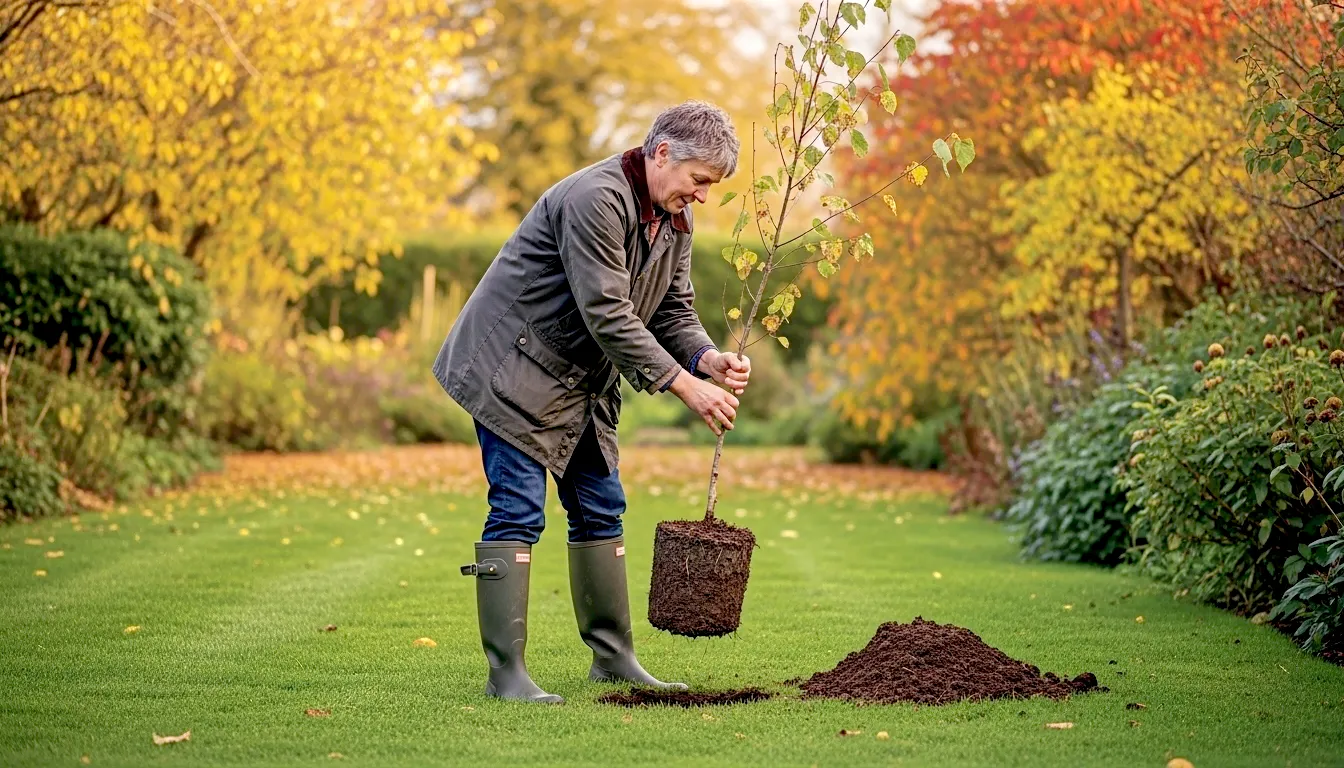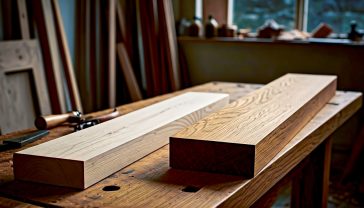A Rooted Guide for British Gardens: When is the Very Best Time to Plant a Tree?
Discover the best time to plant trees in your British garden. This comprehensive guide explains everything from seasonal timing to aftercare.

This post may contain affiliate links. If you make a purchase through these links, we may earn a commission at no additional cost to you.
There’s an old saying you might’ve heard: “The best time to plant a tree was 20 years ago. The second-best time is now.” It’s a lovely thought, isn’t it? It speaks of foresight, of leaving a legacy. But while the sentiment is spot on, the timing isn’t quite so simple. If you’ve ever stood in a garden centre, holding a sapling and wondering, “Right, what now?”, you’re not alone.
Planting a tree feels like a grand, hopeful act. It’s a promise of shade on a sunny day, a burst of blossom in spring, or a home for chirping birds. But getting it wrong can lead to a sad, withered stick where a mighty oak should be. Here in Britain, with our famously unpredictable weather, timing is everything. It’s the difference between a tree that merely survives and one that truly thrives, becoming a cherished part of your garden for decades to come.
So, when is the best time to plant a tree in the UK? The short answer is: it depends. It depends on the tree, the soil, and where in the country you’re digging the hole. But don’t worry. This guide will walk you through everything you need to know. We’ll dig into the science, explore the seasons, and give you the confidence to plant the right tree, at the right time, in the right way.
The Great Debate: Autumn vs. Spring Planting
For generations of British gardeners, there’s been a friendly rivalry between two seasons: autumn and spring. Both have their champions, and for good reason. Understanding the pros and cons of each is the first step to becoming a tree-planting expert.
The magic of planting all comes down to what’s happening below the ground. A tree’s life depends on its roots. When you plant a tree, its first job is to establish a strong root system. These roots anchor it firmly in the ground and suck up the water and nutrients it needs to grow. The best planting time gives the roots a head start before the tree has to deal with the stress of extreme weather, be it the scorching sun of summer or the biting winds of winter.
This crucial period of root growth happens when the tree itself is dormant. Think of dormancy as a long, deep sleep. For most trees, this happens in the colder months. They drop their leaves, stop growing, and save their energy. While the top of the tree is resting, the roots can get to work in the cool, damp soil, quietly spreading out and getting comfortable in their new home.
Why Autumn is Often Crowned King
In the UK, autumn (from October to December) is traditionally considered the prime time for planting trees. As the air cools and the leaves turn golden, the soil is still holding onto some of the summer’s warmth. This creates the perfect environment for root growth.
Imagine it like this: the tree has finished its busy season of producing leaves and growing taller. Now it can focus all its energy on its foundations. The damp, mild autumn soil is easy for roots to push through. They have the whole of autumn and winter to spread out and establish themselves.
The Benefits of Autumn Planting:
- Warm Soil, Cool Air: This is the ideal combination. The warm soil encourages roots to grow, while the cool air means the tree doesn’t need much water, as it isn’t losing moisture through its leaves.
- A Long Head Start: With months to settle in before the demands of spring growth, the tree is well-prepared. When spring arrives, it’s ready to burst into life, putting out strong, healthy leaves and shoots.
- Nature’s Watering Can: British autumns are reliably damp. You’ll spend less time with the hosepipe, as the seasonal rain will do most of the watering for you.
- Less Stress: Planting is a stressful experience for a tree. An autumn planting gives it a long, quiet recovery period.
By the time the first buds appear in spring, an autumn-planted tree already has a functioning root network, ready to supply the water and nutrients needed for that vigorous burst of new growth.
The Case for a Spring Fling
While autumn often takes the top spot, spring (from February to April) is another excellent window for planting, especially in certain situations. As the ground begins to thaw and the days get longer, the soil is once again moist and workable.
Planting in spring is like waking the tree up and immediately giving it a new home. The rising temperatures encourage both root and shoot growth at the same time. This can work well, but it does put a bit more pressure on the tree.
The Benefits of Spring Planting:
- Avoiding Winter’s Wrath: In colder, wetter parts of the UK, like northern Scotland or exposed coastal areas, a harsh winter can be tough on a newly planted sapling. Frost can heave it out of the ground, and waterlogged soil can rot its delicate roots. Spring planting avoids these risks.
- Better for Tender Species: Some trees, especially certain ornamental or fruit trees, are a bit more sensitive to cold. Planting them in spring gives them a full growing season to toughen up before their first winter.
- Gardener’s Enthusiasm: Let’s be honest, spring is when many of us feel most inspired to get out in the garden! It’s a season of new beginnings, and planting a tree fits that mood perfectly.
The main challenge with spring planting is the race against time. The tree needs to establish its roots quickly before the weather turns hot and dry. A late cold snap can also damage new growth. You’ll need to be extra vigilant with watering throughout the tree’s first summer to make sure it doesn’t dry out.
So, what’s the verdict?
For most deciduous trees (the ones that lose their leaves in winter) in most parts of the UK, autumn is the gold standard. However, for evergreen trees or in very cold, wet regions, spring is often a safer bet.
Not All Trees Are Created Equal: Timing for Different Types
Just as you wouldn’t wear a winter coat on a summer’s day, you can’t treat every tree the same. How a tree is sold—and whether it keeps its leaves year-round—makes a big difference to its ideal planting time.
Bare-Root Trees: The Traditional Choice
What are they? These are trees that are dug up from a field when they are dormant and sold with their roots exposed, packed in something damp like sawdust. They are usually the most affordable option and are perfect for planting hedges or creating small woodlands.
When to plant them? Strictly during the dormant season, from November to March. Planting a bare-root tree outside of this window is a recipe for disaster. The roots will dry out and die before they have a chance to grow.
Because their roots are exposed, they need to be planted quickly after you buy them. If you can’t plant them straight away, you can ‘heel them in’—a fancy term for temporarily burying the roots in a trench of soil to keep them moist.
Root-Balled Trees: A Bit of Both Worlds
What are they? These are usually larger, more mature trees. They are also grown in a field, but when they are dug up, a large ball of soil is kept intact around the roots. This is then wrapped in hessian or a wire mesh.
When to plant them? Like bare-root trees, they should be planted during the dormant season, from October to April. The ball of soil gives the roots some protection, but they are still vulnerable. The hessian wrapping can be planted with the tree (it will rot away), but you should always remove any wire mesh, as it can strangle the roots as they grow.
Container-Grown Trees: The Year-Round Option?
What are they? This is what most of us see at the garden centre. These trees have been grown in a pot for their entire lives. Their root system is completely self-contained and undisturbed.
When to plant them? Technically, you can plant a container-grown tree at any time of year. Because you aren’t disturbing the roots, the tree experiences less shock.
However, that doesn’t mean any time is the best time. Planting a container-grown tree in the middle of summer is possible, but it’s a risky business. The tree will be trying to support a full canopy of leaves in the hot sun with a root system that’s still confined to the shape of its pot. It will need a huge amount of water—potentially twice a day—to survive.
Even for container-grown trees, autumn remains the ideal time. Planting in autumn gives the roots the chance to break free from their pot-shaped confines and explore the surrounding soil before the stress of summer arrives. Spring is the next best choice.
Deciduous vs. Evergreen: A Tale of Two Timetables
The type of leaves a tree has also influences its perfect planting schedule.
- Deciduous Trees: These are trees like oak, birch, apple, and cherry that drop their leaves in autumn. As we’ve discussed, their long dormant period makes them perfect candidates for autumn planting. They have ample time to establish their roots before they need to produce new leaves in spring.
- Evergreen Trees: These are trees like pine, fir, holly, and yew that keep their leaves all year round. Because they never go fully dormant, they are always losing a small amount of water through their leaves (or needles). In winter, they can struggle to replace this water if their roots are not yet established and the ground is frozen.For this reason, evergreens often do better with a late autumn (October/November) or early spring (March/April) planting. An autumn planting works if the soil is warm enough for root growth, but a spring planting avoids the risk of the tree drying out in cold winter winds—a process known as ‘winter browning’.
Preparing for Success: The Groundwork of Tree Planting
You’ve chosen your tree, you’ve picked your season. Now comes the moment of truth: digging the hole. Proper preparation is just as important as timing. A well-prepared planting site is a welcome mat for your new tree, encouraging its roots to grow far and wide.
Step 1: Choosing the Perfect Spot
Before you even think about digging, take a good look around your garden. Consider the tree’s ultimate size. That tiny sapling might look sweet now, but in 20 years, it could be casting a huge shadow or threatening your foundations. Read the label carefully. Don’t plant a mighty oak in a tiny front garden.
Think about:
- Sunlight: Does the tree need full sun or can it tolerate some shade?
- Soil: Most trees aren’t too fussy, but some prefer acidic soil (like rhododendrons) while others prefer alkaline soil (like beech). You can buy a simple testing kit to check your soil’s pH.
- Drainage: Trees hate having ‘wet feet’. If you have heavy clay soil that gets waterlogged in winter, you may need to improve the drainage or build a raised mound to plant the tree on. To test drainage, dig a hole about a foot deep and fill it with water. If it hasn’t drained away after a few hours, you may have a problem.
- Proximity to Buildings and Pipes: Keep trees well away from your house, garage, and underground pipes. Their roots can cause serious damage over time. A good rule of thumb is to plant a tree at least half its eventual spread away from any structure.
Step 2: Digging the Right Hole
Forget what you might have seen—a deep, narrow hole is not what you want. A tree’s roots grow outwards, not straight down. You need to dig a hole that is wide and shallow.
- Width: The hole should be at least three times the width of the tree’s root ball or container. This is the most important rule of hole-digging! Loosening the soil over a wide area makes it easy for the roots to spread out.
- Depth: The hole should be no deeper than the root ball. Planting a tree too deep is one of the most common and fatal mistakes. The point where the trunk meets the roots (the ‘root collar’) needs to be level with or slightly above the surrounding soil.
When you’re digging, separate the topsoil from the subsoil. The topsoil is darker and richer in nutrients, and you’ll want to put this back in the bottom of the hole where the roots can access it.
Step 3: Preparing the Tree
- For Container-Grown Trees: Gently remove the tree from its pot. If the roots are tightly coiled and circling the bottom (a sign it’s ‘pot-bound’), you need to tease them out. Don’t be afraid to be firm. Use your fingers or an old fork to gently loosen the roots and encourage them to grow outwards. If you plant it with the roots still in a tight ball, they may never spread into the surrounding soil.
- For Bare-Root Trees: Give the roots a good soak in a bucket of water for an hour or two before planting. Trim off any roots that are broken or look damaged.
- For Root-Balled Trees: Place the whole ball in the hole, then cut away any string or wire. You can leave the hessian fabric on, as it will rot away naturally.
Step 4: Planting and Backfilling
Place the tree in the centre of the hole. Use a bamboo cane or a plank of wood laid across the hole to check the depth. The top of the root ball or the root collar should be level with the ground.
Now, backfill the hole with the soil you dug out, breaking up any large clumps. Gently firm the soil down with your heel as you go to get rid of any air pockets. Don’t stamp on it too hard—you’ll compact the soil and make it difficult for the roots to breathe.
There’s generally no need to add lots of compost or manure to the planting hole. While it seems like a good idea, you want to encourage the roots to grow out into the native soil, not just stay in a small pocket of enriched compost. The exception is if you have very poor, sandy soil, in which case mixing in some well-rotted organic matter can help it hold onto water.
Aftercare: Nurturing Your New Tree
Your job isn’t done once the tree is in the ground. The first year is the most critical period in a tree’s life. Proper aftercare will ensure it gets the best possible start.
To Stake or Not to Stake?
It might surprise you, but most small trees do not need staking. A little bit of movement in the wind actually helps the tree to develop a stronger trunk and root system.
You should only stake a tree if:
- It’s a ‘top-heavy’ standard tree with a small root ball.
- It’s planted in a very windy, exposed location.
- It’s a bare-root tree that needs extra support until its roots take hold.
If you do need to stake, use a short stake and a flexible tree tie. The aim is to stop the root ball from rocking, not to hold the trunk completely rigid. The stake should be placed at a 45-degree angle, pointing into the prevailing wind. And most importantly, remove the stake and tie after 18 months to two years. If you leave it on, it will strangle the tree as it grows.
Watering: The Elixir of Life
Watering is the single most important part of aftercare. A newly planted tree does not have a wide-reaching root system, so it can’t find water for itself. You need to provide it.
- How much? Give it a really good soak immediately after planting. Then, water it thoroughly once or twice a week during its first growing season (from spring to autumn). A deep soaking is much better than a light sprinkle every day. You want to encourage the roots to grow down in search of water.
- How to tell? Don’t just look at the surface. Dig down a few inches with your fingers a little way from the trunk. If the soil feels dry, it’s time to water.
- Be vigilant in summer. During hot, dry spells, your tree will need a lot of water. Don’t rely on the rain unless it’s a sustained, heavy downpour.
Mulching: The Gardener’s Secret Weapon
Mulching is simply applying a layer of organic material, like bark chips or well-rotted compost, on the surface of the soil around the base of the tree. It’s one of the best things you can do for your new plant.
A good layer of mulch (about 2-3 inches deep) will:
- Suppress weeds: Weeds compete with the tree for water and nutrients.
- Conserve moisture: It acts like a lid, stopping water from evaporating from the soil surface.
- Regulate soil temperature: It keeps the soil cooler in summer and warmer in winter.
When you apply the mulch, leave a small, collar-like gap around the base of the trunk. Piling mulch right up against the bark can cause it to rot.
Regional Roundup: A British Tour of Tree Planting
The UK might be a small island, but its climate varies dramatically from the mild, damp corners of Cornwall to the windswept peaks of the Cairngorms. These regional differences can tweak the ideal planting calendar.
- The South of England (South West, South East, London): With milder winters and warmer soils, autumn planting (October to December) is almost always best here. The longer growing season gives trees plenty of time to establish. However, summers can be hotter and drier, so spring-planted trees will need very careful watering.
- The Midlands and East Anglia: The climate here is more continental, with colder winters and drier summers. Autumn planting is still preferable, but you might want to wait until late October or November when there’s more moisture in the ground.
- The North of England, Wales, and Northern Ireland: Winters here are colder and wetter. While autumn planting can still work in sheltered spots, heavy, waterlogged soil can be a real problem. For these areas, early spring (March) is often a safer bet. This avoids the risk of the young tree sitting in freezing, sodden soil for months on end.
- Scotland: In the Scottish Lowlands, the advice is similar to the north of England. But in the Highlands and other exposed areas, winter conditions can be severe. Here, spring planting (late March to April) is strongly recommended. The ground will be unworkable for much of the winter anyway, and a young tree planted in autumn would face a real battle for survival.
No matter where you live, the golden rule is to check the conditions on the ground. Don’t plant into frozen, waterlogged, or bone-dry soil. It’s always better to wait a few weeks for the conditions to improve.
A Final Word: Plant for the Future
Planting a tree is an investment. It’s an act of faith in the future. By choosing the right time and taking a little care, you are giving that investment the very best chance to grow, flourish, and reward you for many years to come.
So, whether you’re drawn to the fiery colours of an autumn acer, the delicate blossom of a spring-time cherry, or the steadfast green of a mighty pine, there is a perfect time to welcome it into your garden. The next time you stand with a sapling in your hands, you’ll know exactly what to do. You’re not just planting a tree; you’re planting a legacy. And the best time to start is just around the corner.
Further Reading
For more detailed information and specific advice, these resources are highly recommended for UK gardeners:
- The Royal Horticultural Society (RHS): https://www.rhs.org.uk/advice/profile?pid=237
- The Woodland Trust: https://www.woodlandtrust.org.uk/plant-trees/advice/when-to-plant/
- Gardeners’ World: https://www.gardenersworld.com/how-to/grow-plants/how-to-plant-a-tree/






